Abstract
1. The effects of dimethothiazine have been studied on the response of afferent fibres from primary and secondary endings of muscle spindles in the soleus muscle of the decerebrate cat during stretching of the muscle under controlled conditions.
2. Dimethothiazine in doses of 1 to 4 mg/kg intravenously reduced the discharge frequency of primary and secondary endings. Higher doses of dimethothiazine had little further significant effect on the discharge frequency.
3. The discharge frequency recorded from de-efferented muscle spindles in soleus of the decerebrate cat were similar to the discharge frequencies obtained in preparations with intact ventral roots which had received a high dose of dimethothiazine.
4. Dimethothiazine had little significant effect on the discharge frequency of afferent fibres from muscle spindles in the soleus muscle of decerebrate preparations where the ventral roots were cut.
5. These effects of dimethothiazine on muscle spindle activity were not related to any changes in blood pressure of the decerebrate cat.
6. Dimethothiazine appears to reduce the effects of both the dynamic and static fusimotor fibres on the spindle.
7. The doses of dimethothiazine which effect spindle discharge frequency are similar to those required to reduce decerebrate rigidity.
Full text
PDF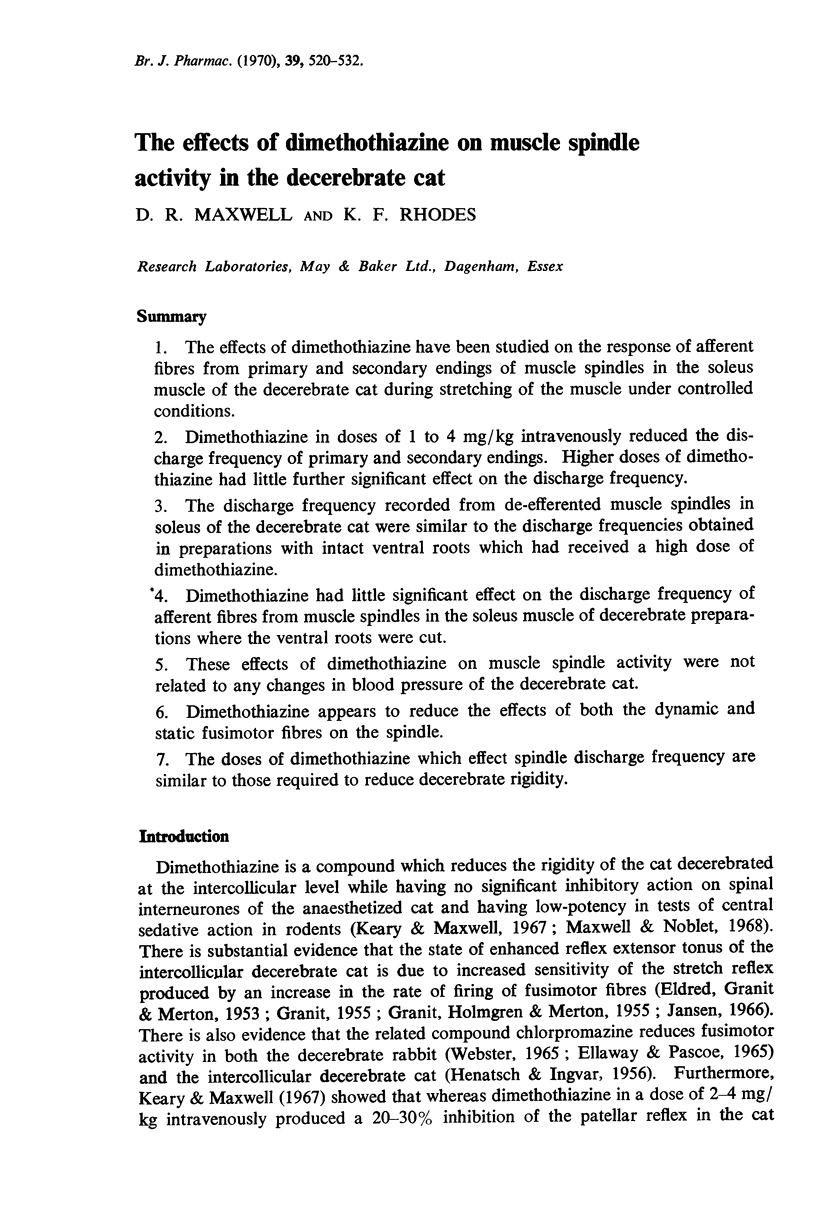
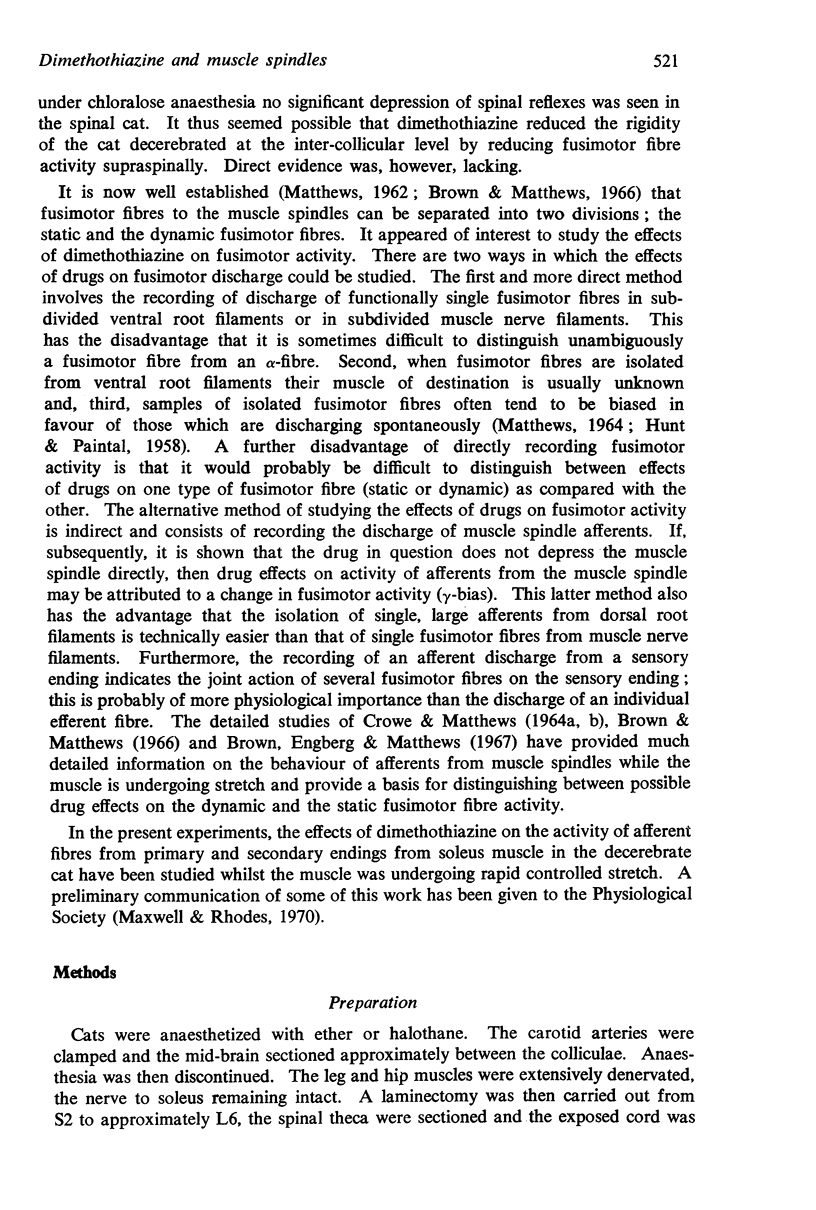
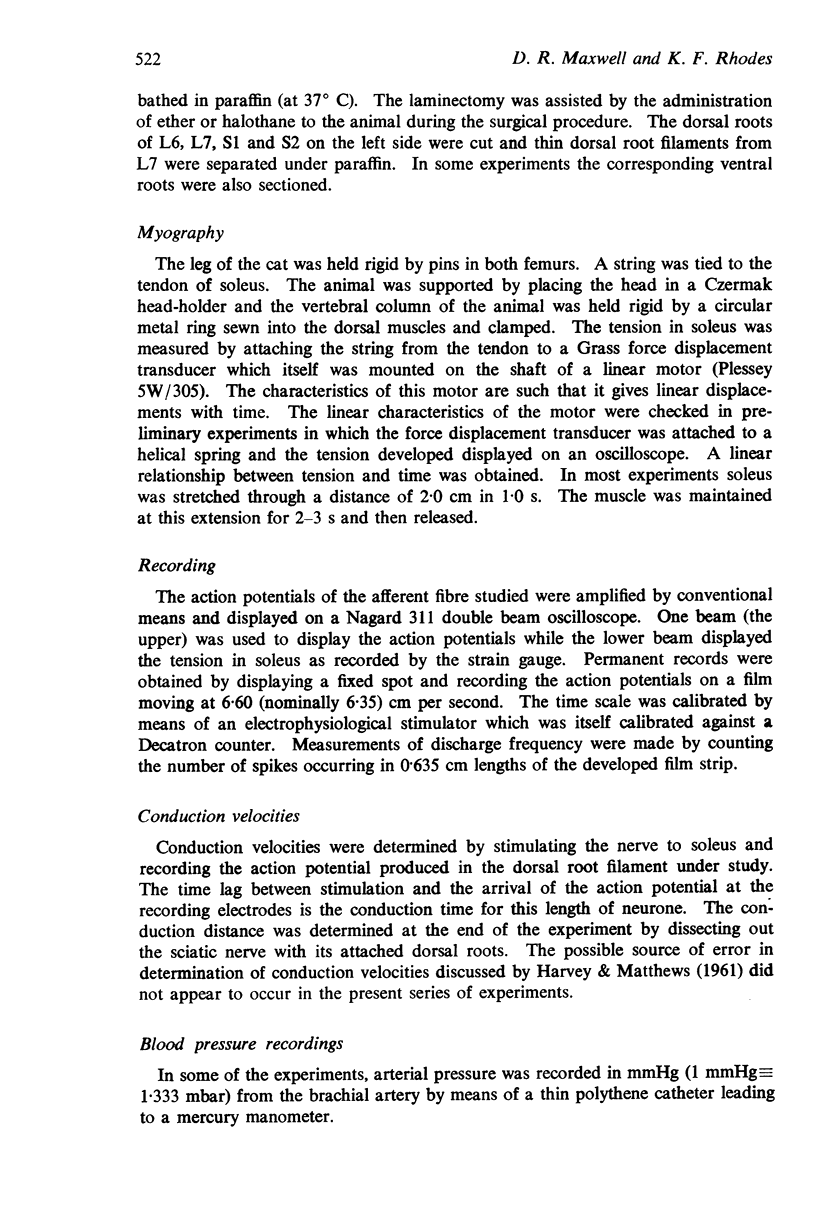
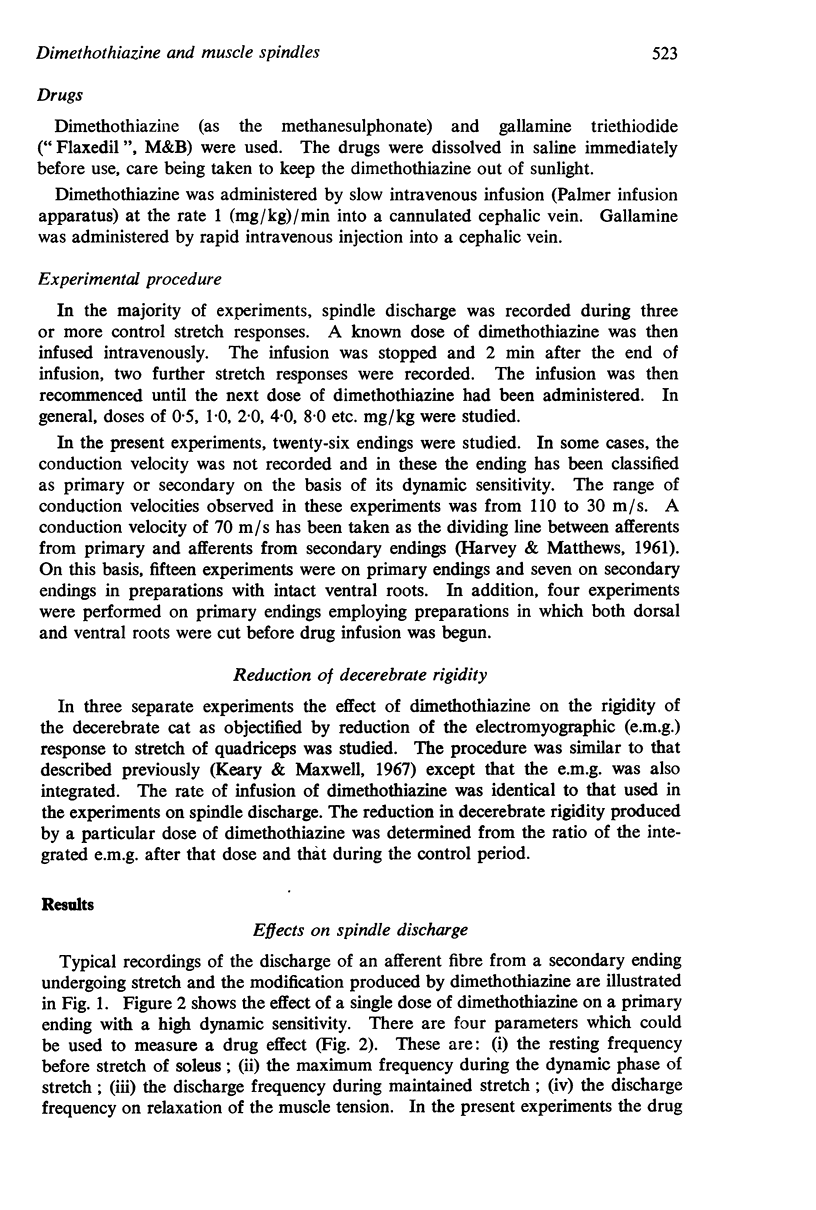
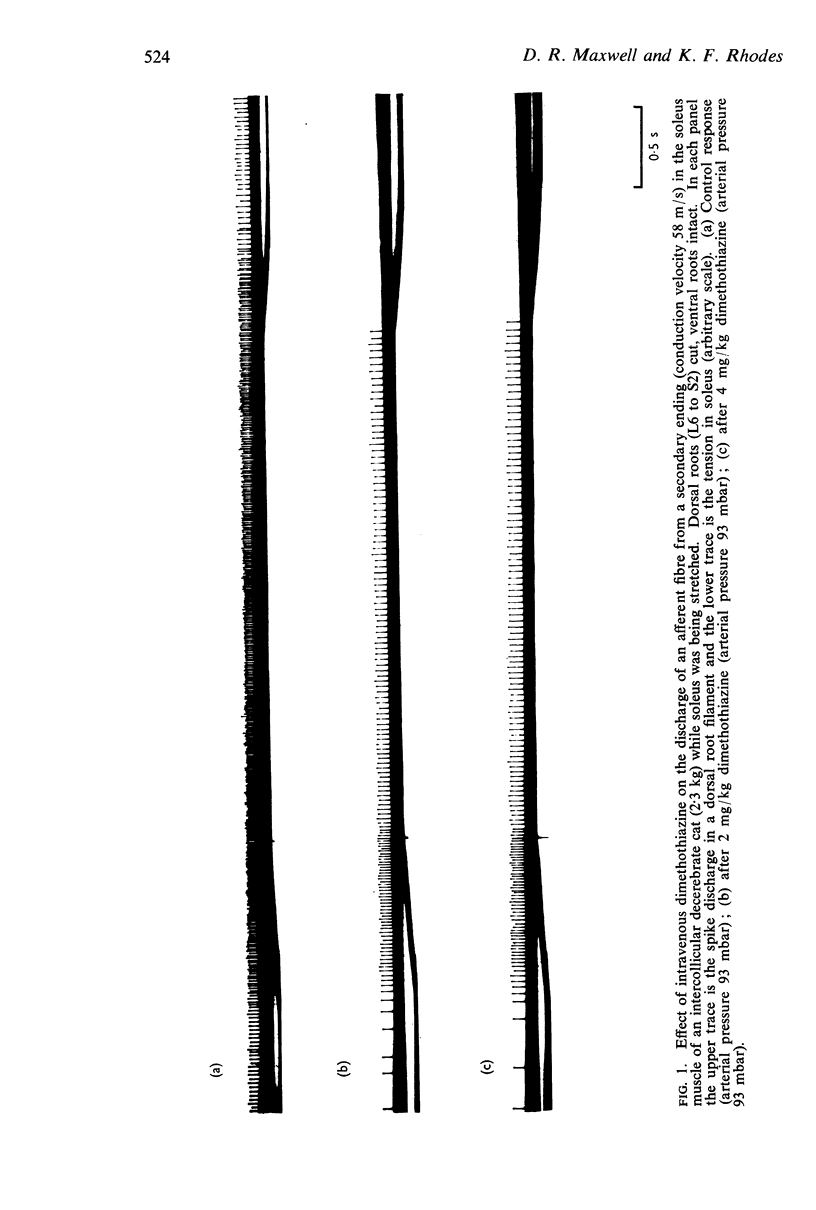
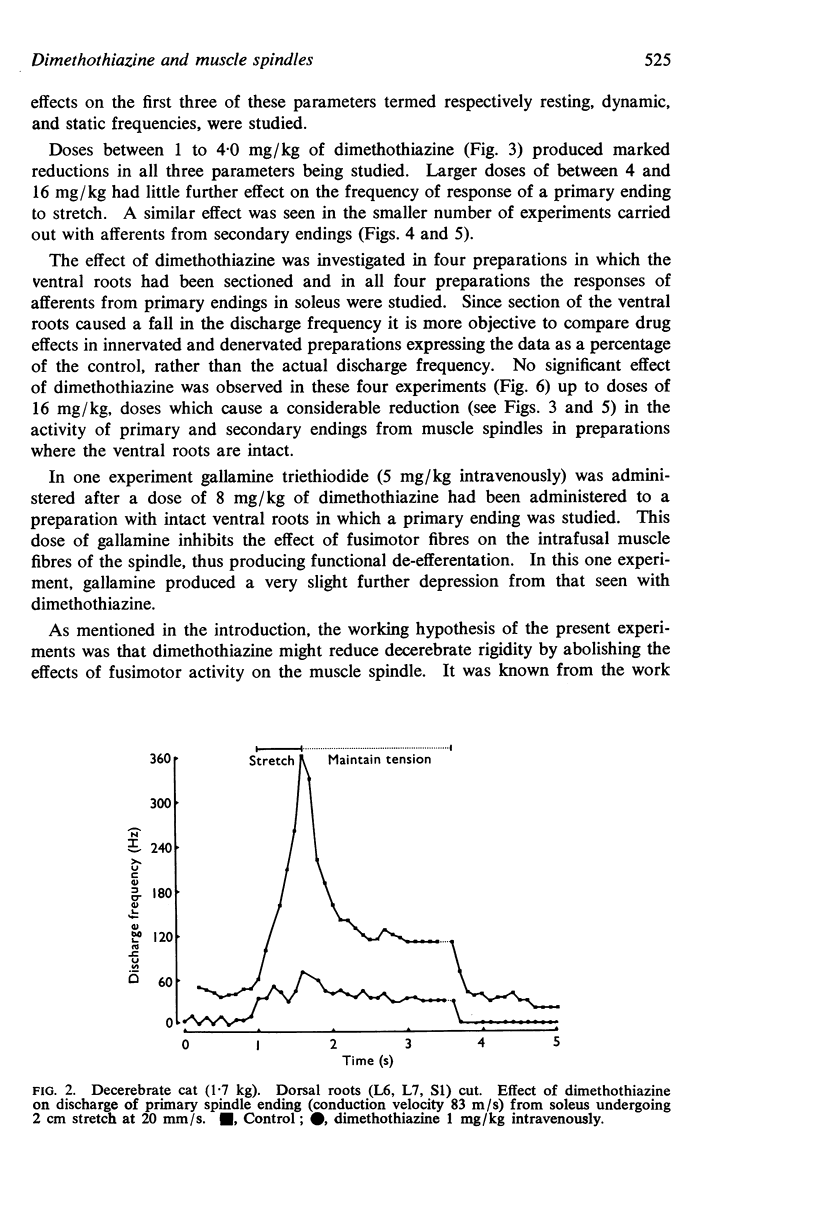
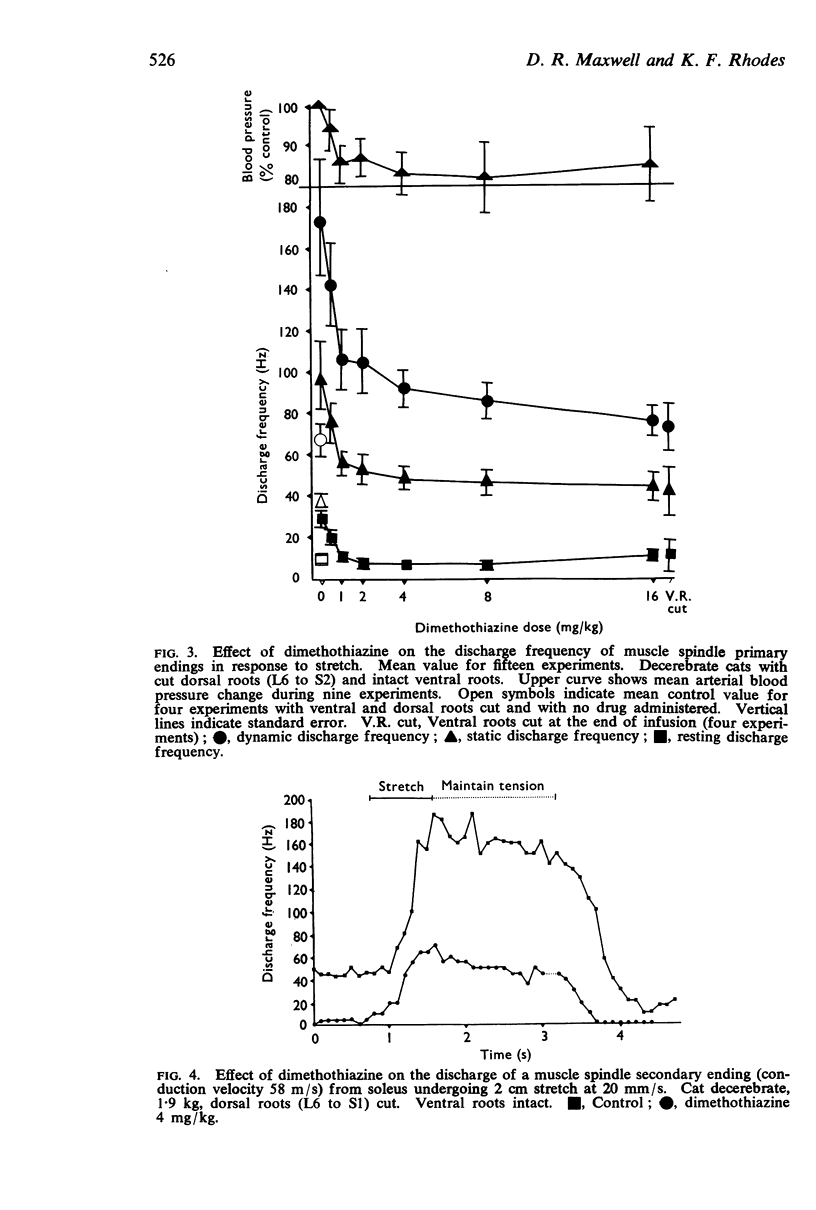
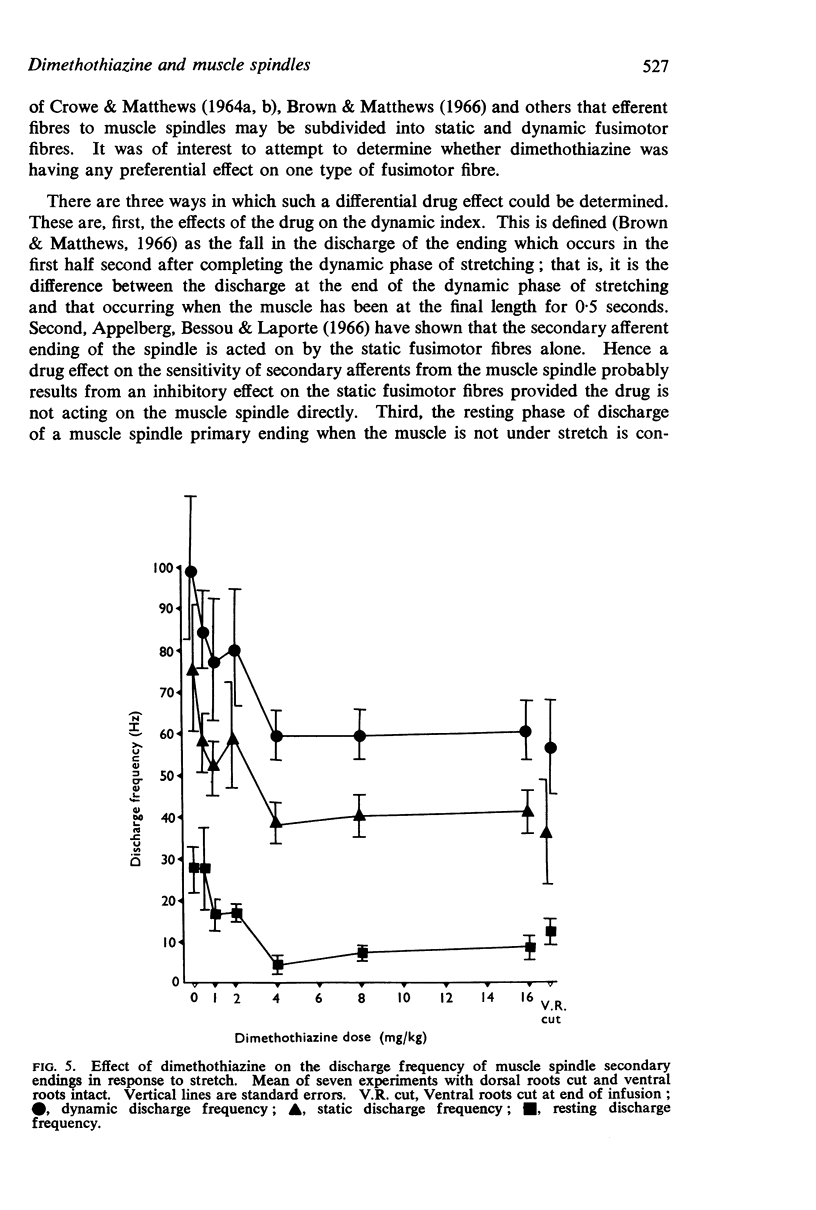
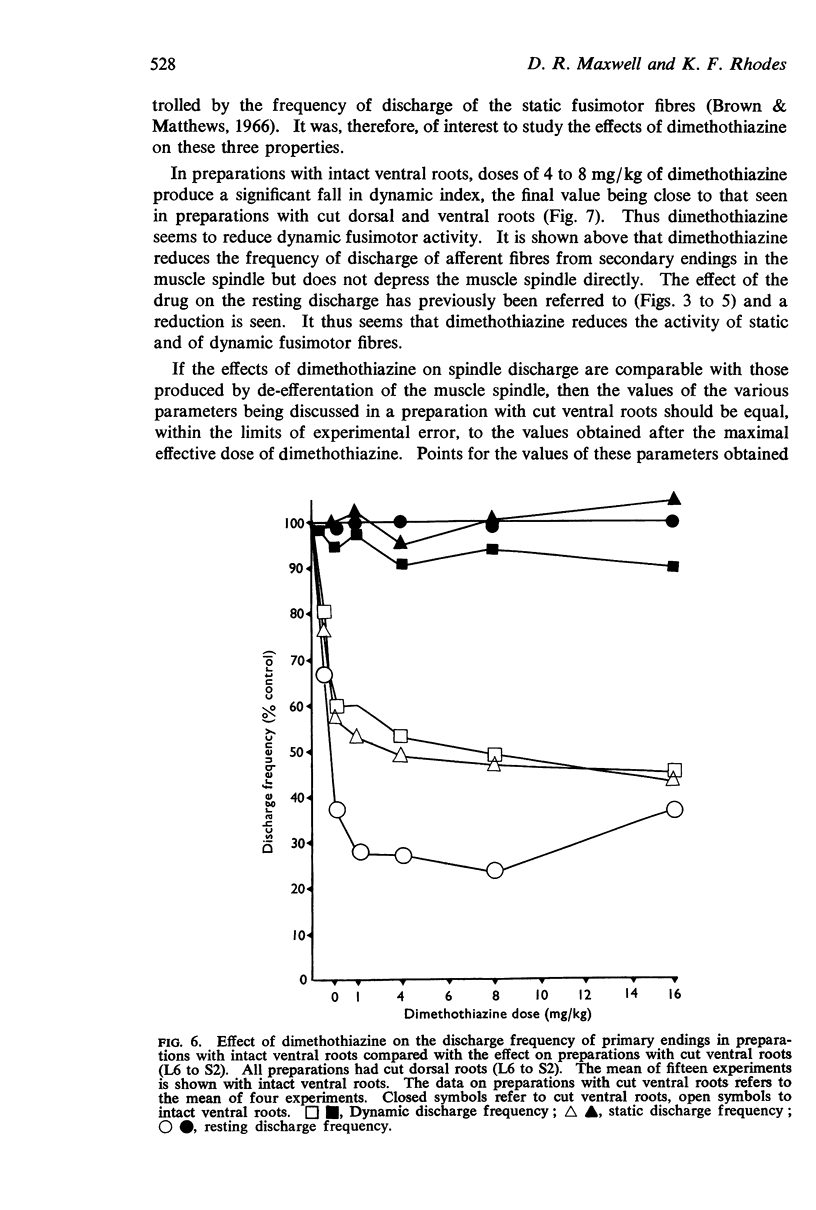
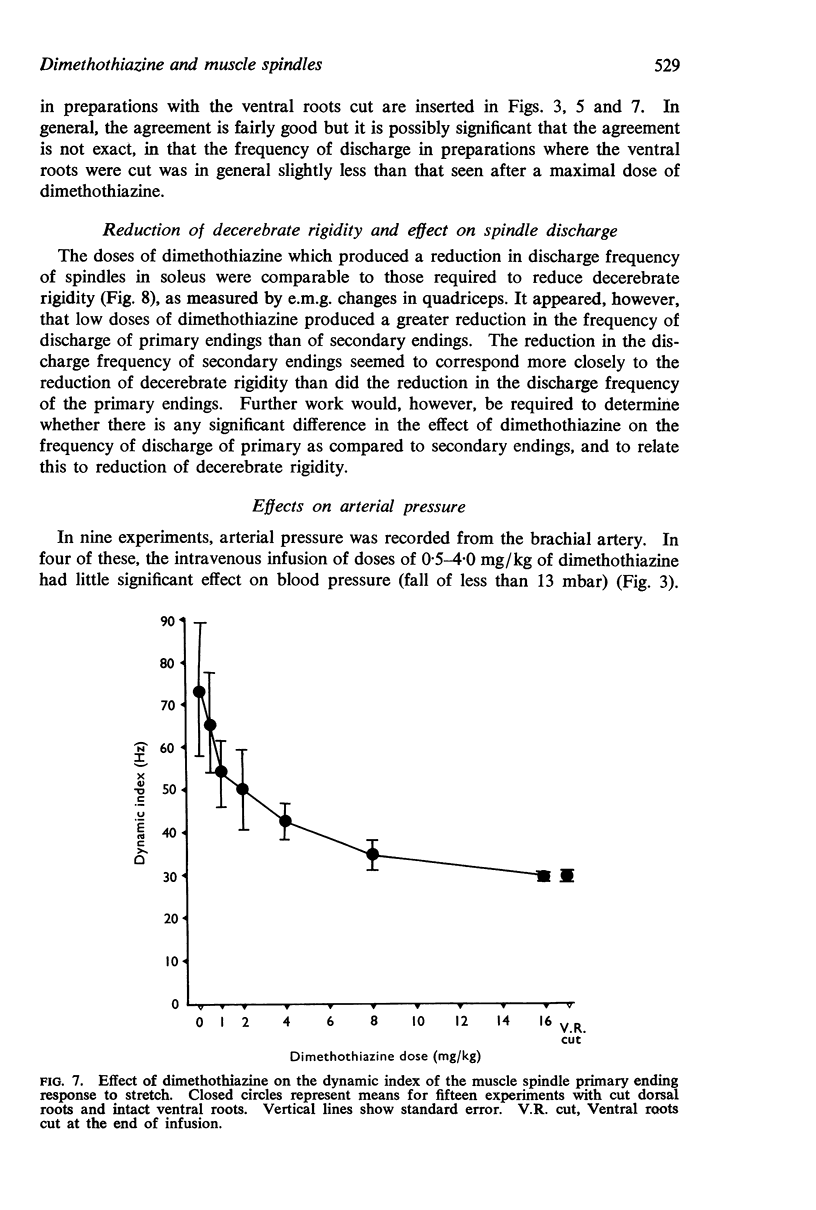

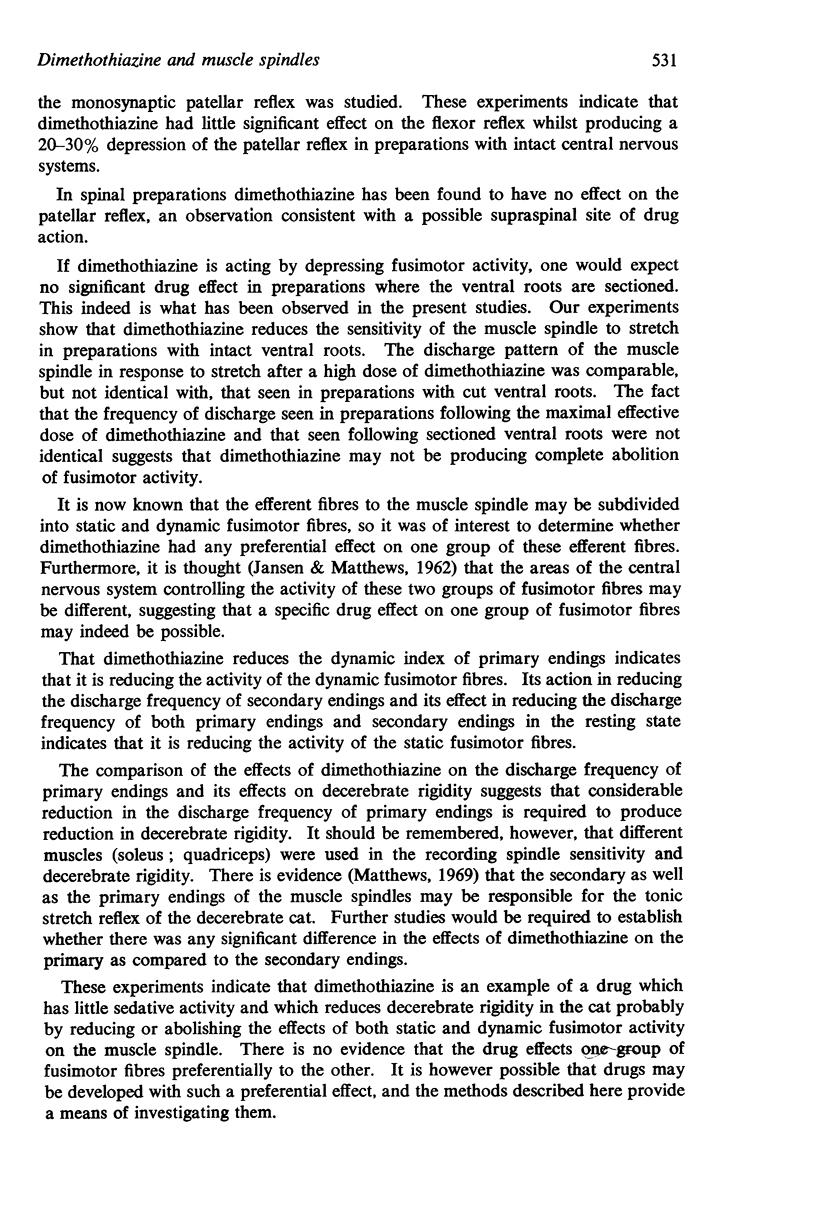
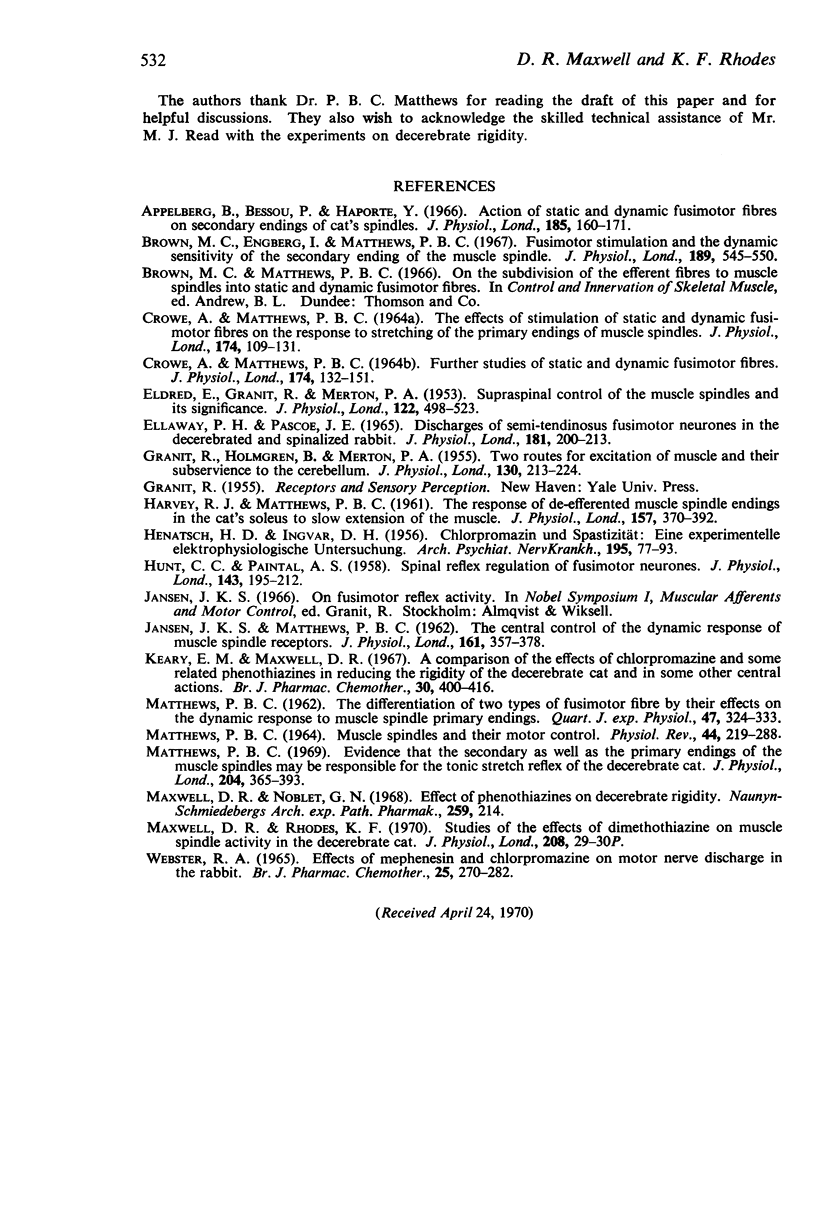
Selected References
These references are in PubMed. This may not be the complete list of references from this article.
- Appelberg B., Bessou P., Laporte Y. Action of static and dynamic fusimotor fibres on secondary endings of cat's spindles. J Physiol. 1966 Jul;185(1):160–171. doi: 10.1113/jphysiol.1966.sp007978. [DOI] [PMC free article] [PubMed] [Google Scholar]
- Brown M. C., Engberg I., Matthews P. B. Fusimotor stimulation and the dynamic sensitivity of the secondary ending of the muscle spindle. J Physiol. 1967 Apr;189(3):545–550. doi: 10.1113/jphysiol.1967.sp008184. [DOI] [PMC free article] [PubMed] [Google Scholar]
- CROWE A., MATTHEWS P. B. FURTHER STUDIES OF STATIC AND DYNAMIC FUSIMOTOR FIBRES. J Physiol. 1964 Oct;174:132–151. doi: 10.1113/jphysiol.1964.sp007477. [DOI] [PMC free article] [PubMed] [Google Scholar]
- CROWE A., MATTHEWS P. B. THE EFFECTS OF STIMULATION OF STATIC AND DYNAMIC FUSIMOTOR FIBRES ON THE RESPONSE TO STRETCHING OF THE PRIMARY ENDINGS OF MUSCLE SPINDLES. J Physiol. 1964 Oct;174:109–131. doi: 10.1113/jphysiol.1964.sp007476. [DOI] [PMC free article] [PubMed] [Google Scholar]
- ELDRED E., GRANIT R., MERTON P. A. Supraspinal control of the muscle spindles and its significance. J Physiol. 1953 Dec 29;122(3):498–523. doi: 10.1113/jphysiol.1953.sp005017. [DOI] [PMC free article] [PubMed] [Google Scholar]
- Ellaway P. H., Pascoe J. E. Discharges of semitendinosus fusimotor neurones in the decerebrated and spinalized rabbit. J Physiol. 1965 Nov;181(1):200–213. doi: 10.1113/jphysiol.1965.sp007755. [DOI] [PMC free article] [PubMed] [Google Scholar]
- GRANIT R., HOLMGREN B., MERTON P. A. The two routes for excitation of muscle and their subservience to the cerebellum. J Physiol. 1955 Oct 28;130(1):213–224. doi: 10.1113/jphysiol.1955.sp005404. [DOI] [PMC free article] [PubMed] [Google Scholar]
- HARVEY R. J., MATTHEWS P. B. The response of de-efferented muscle spindle endings in the cat's soleus to slow extension of the muscle. J Physiol. 1961 Jul;157:370–392. doi: 10.1113/jphysiol.1961.sp006729. [DOI] [PMC free article] [PubMed] [Google Scholar]
- HENATSCH H. D., INGVAR D. H. Chlorpromazin und Spastizität; eine experimentelle elektrophysiologische Untersuchung. Arch Psychiatr Nervenkr Z Gesamte Neurol Psychiatr. 1956;195(1):77–93. doi: 10.1007/BF00342008. [DOI] [PubMed] [Google Scholar]
- HUNT C. C., PAINTAL A. S. Spinal reflex regulation of fusimotor neurones. J Physiol. 1958 Sep 23;143(2):195–212. doi: 10.1113/jphysiol.1958.sp006053. [DOI] [PMC free article] [PubMed] [Google Scholar]
- JANSEN J. K., MATTHEWS P. B. The central control of the dynamic response of muscle spindle receptors. J Physiol. 1962 May;161:357–378. doi: 10.1113/jphysiol.1962.sp006892. [DOI] [PMC free article] [PubMed] [Google Scholar]
- Keary E. M., Maxwell D. R. A comparison of the effects of chlorpromazine and some related phenothiazines in reducing the rigidity of the decerebrate cat and in some other central actions. Br J Pharmacol Chemother. 1967 Jun;30(2):400–416. doi: 10.1111/j.1476-5381.1967.tb02147.x. [DOI] [PMC free article] [PubMed] [Google Scholar]
- MATTHEWS P. B. MUSCLE SPINDLES AND THEIR MOTOR CONTROL. Physiol Rev. 1964 Apr;44:219–288. doi: 10.1152/physrev.1964.44.2.219. [DOI] [PubMed] [Google Scholar]
- MATTHEWS P. B. The differentiation of two types of fusimotor fibre by their effects on the dynamic response of muscle spindle primary endings. Q J Exp Physiol Cogn Med Sci. 1962 Oct;47:324–333. doi: 10.1113/expphysiol.1962.sp001616. [DOI] [PubMed] [Google Scholar]
- Matthews P. B. Evidence that the secondary as well as the primary endings of the muscle spindles may be responsible for the tonic stretch reflex of the decerebrate cat. J Physiol. 1969 Oct;204(2):365–393. doi: 10.1113/jphysiol.1969.sp008918. [DOI] [PMC free article] [PubMed] [Google Scholar]


